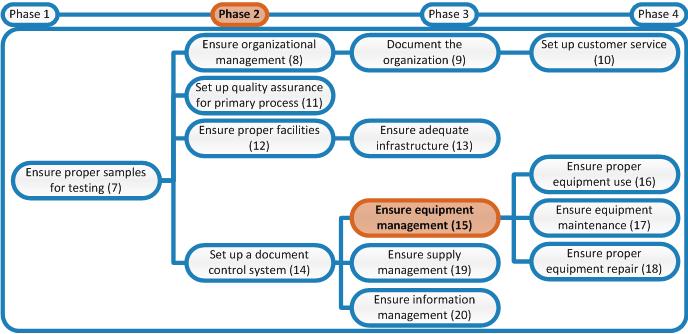
Title
Why
It is important that exactly the right piece of equipment, complying with all the predefined requirements, is purchased and that upon reception equipment is checked on all critical points. Ensuring that the equipment is functioning correctly, complying to all the requirements of the laboratory, and delivering a quality product is a valuable contribution to assuring the quality of the analytical process.
This is also the reason why equipment that is given to the laboratory free of charge should not be accepted without further investigation. If the laboratory is given a piece of equipment for which reagents are very hard to get or which is impossible to maintain/repair because no specialized maintenance company is present within the country, the laboratory has no use for this piece of equipment as a quality result cannot be assured.
What
Write an SOP for Procurement and Reception of Equipment. This SOP must cover the following procedures:
- Formulating specific requirements to equipment that has to be purchased:
When equipment needs to be purchased, a small group of staff members that are going to use the new equipment needs to be formed to discuss and formulate specific requirements they want the new piece of equipment to comply with. - Standard requirements that need to be taken into account for every equipment order, such as:
- 10% of the tender budget must be spend on spare parts and maintenance.
- Requirements regarding the limitation of energy use and the burden to the environment when the equipment is disposed of.
Sometimes equipment contains chemical materials that are harmful to the environment and/or humans. In this case this piece of equipment must be processed by a specialized company when disposed of to prevent damage to the environment and the health of the public. When these types of companies are not available it is better to try to find alternative pieces of equipment without these chemical materials. Also the use of energy must be limited: a piece of equipment unnecessarily using large amounts of energy also forms a burden to the environment, electricity network and the budget of the laboratory who has to pay for the electricity use. Try to find equipment that uses a limited amount of energy.
- Making an inventory of possible suitable equipment from different suppliers and selecting the best offer based on a checklist.
- The ordering process.
- Reception of equipment.
- A reception checklist to verify that the appropriate model is received as ordered, and that the equipment is functioning correctly and achieving performance requirements.
- A procedure for acceptance or rejection of donated equipment
A laboratory that has a quality management system in place must also perform acceptance testing on donated equipment. If the equipment doesn't comply with the specifications of the laboratory, the laboratory should not accept the equipment as it will not be able to assure quality results with that equipment. Problems with unsuitable donated equipment can only be solved if laboratories enter into dialogue with their donators and explain that the equipment needs to comply with the laboratory's own specifications, however sensitive this may be. - Installation of the equipment.
- Making a staff member responsible for the piece of equipment and authorizing staff members to use the piece of equipment (task of the laboratory manager). Instruction of these staff members on their tasks and responsibilities (task of the Equipment Officer).
- Assembling the equipment file with the necessary documents and records:
- An SOP
- A file with all the equipment records (e.g. certificate, manufacturer instructions/user manual, service contracts, maintenance logs, etc.).
- Adapting the Equipment Register to include the new piece of equipment.
This SOP must be written as a Procedural SOP. In the right-hand column a link to Master SOP template is provided that contains a template for a Procedural SOP in annex 1. [TB] In the WHO Guidance for countries on the specifications for managing TB laboratory equipments and supplies part A, detailed information can be found on equipment selection and further management. Part B contains specifications for pieces of equipment normally used in TB laboratories.
How & who
Equipment Officer:
- Write the first draft of the SOP following the protocol for writing an Procedure SOP in the Master SOP and use the template for a Procedure SOP attached to the Master SOP.
- Let two colleagues review the SOP according to the SOP for Document Control.
- Once the SOP has been reviewed and authorized, put the SOP in the Procedure SOPs folder and notify staff members in a weekly staff meeting of the existence of the SOP and that it must be followed when new equipment is purchased.


